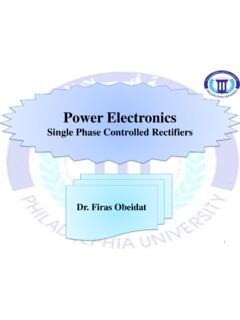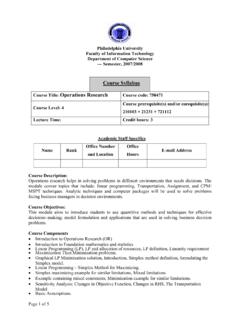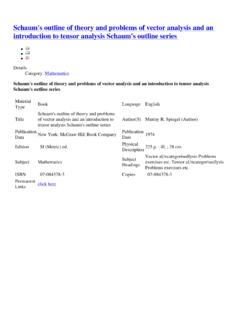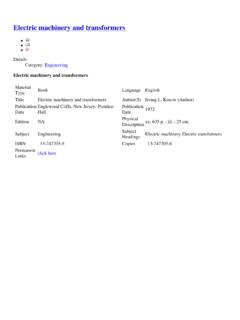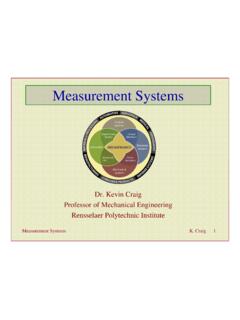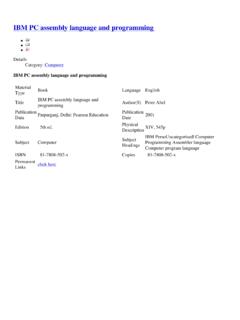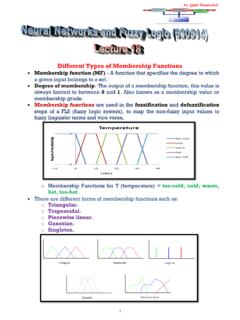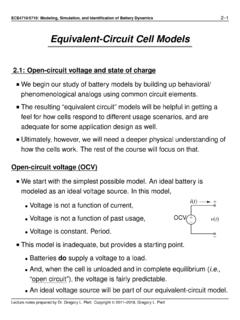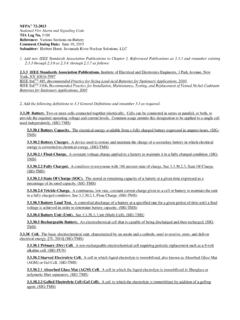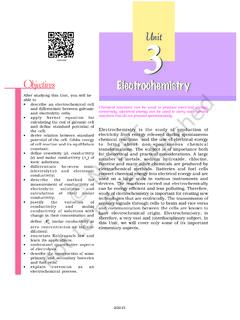Transcription of Introduction to Electrochemical Methods
1 CHEM 540 ADVANCED ANALYTICAL CHEMISTRY CHEM 540 KFUPM CHEM 540, Advanced Analytical Chemistry CHEMISTRY DEPT. Credit hours: 3 Fall 2006/2007 ( Term 061) DR JABER Room 261F, Tel 2611 Office hours : S, U : 9:00 -11:30 AM Textbook : Instrumental Analysis, and 'Reilly, Second edition, Ellyn and Bacon, 1986. Supplement: Principles of Instrumental Analysis, D. A. Skoog, F. J. Holler and T. A. Nieman, Brooks/Cole, 1998 Catalogue Description CHEM 540 Advanced Analytical Chemistry (3-0-3) Advanced instrumental analysis: electroanalytical Methods including potentiometry, voltammetry and coulometry.
2 Spectroscopic techniques: AA, FE, ICP, molecular spectroscopy: fluoroscence and phosphorescence. Chromatography: principles GC, HPLC, mass spectrometry. Flow injection analysis technique (FIA). Prerequisite: CHEM 324 or equivalent Teaching Assignments Chapter Subject # of Classes 1 Introduction to Electrochemical Methods 1 Generalities of Electrochemical Methods Electrochemical definitions and terminology 2 Potentiometry 2 Electrochemical cells The Nernst equation Reference electrodes pH: Definition and measurement. Ion-selective electrodes Potentiometric titrations. 3 Polarography and Voltammetry : 4 Introduction and theoretical basis Instrumentation and apparatus Applications.
3 Variations of the conventional polarographic Methods Amperometric titration 7 Ultraviolet and visible absorption spectroscopy 3 Molecular absorption of raduation Effect of structure on absorption Magnitude of absorption of radiation Quantitative absorption spectroscopy Spectrophotometric applications Apparatus and instruments 9 Molecular Fluorescence and Phosphorescence 2 Principles of photoluminescence Fluorescence and phosphorescence instrumentation Applications of fluorescence and phosphorescence 10 Flame Emission, Atomic Absorption and Atomic 2 Fluorescence Spectrometry The flame as a source of atomic vapor Flame emission spectrometry Atomic absorption spectrometry Atomic absorption measurements, Electrothermal atomization Applications Atomic fluorescence spectrometry 11 Inductively Coupled Plasma Emission spectroscopy 2 Principles and theory Qualitative and quantitative analysis Applications.
4 16 Mass Spectrometry 4 Instrumentation in mass spectrometry Interpretation of mass spectrum Analytical applications of electron- impact mass spectrometry Other Methods of vaporization and ionization 21 Solid- and liquid-phase chromatography 3 Introduction Basic principles of liquid chromtog. Theory related to practice Paper and thin layer chromatography Column liquid chromatography Uses and applications of adsorption chromatography Uses and applications of partition and bonded phase chromatography Ion exchange chromatography size exclusion chromatography Techniques related to liquid chromatography 22 Gas Chromatography 2 The thermodynamics of gas chromatography The dynamics of gas chromatography Gas chromatographic instruments Qualitative and quantitative analysis Applications of gas chromatography XX Supercritical Fluid Chromatography and Extraction 1 Principles and comparison to other types Instrumentation
5 And applications XX Capillary Electrophoresis and capillary electrochromatography 2 Principles, instrumentation and applications References 1. Instrumental Methods of Analysis. Willard, Merritt, Dean and Settle, Allyn and Bacon, New York, latest edition 2. Modern Methods of Chemical Analysis, R. L. Pecsok, L. D. Shields, T. Cairns, and I. G. McWilliam, John Wiley, New York, 1978. 3. Instrumental Analysis, C. K. Mann, T. J. Vickers and W. M. Gulick, Harper and Row, New York, 1974. 4. Modern Optical Methods of Analysis, E. D. Olsen, McGraw Hill, 1975. Project Assignments and Homework Every student is requested to make written (a maximum of 10 pages) and oral (Power Point) presentations on two chemical instrumentation topics from those assigned in the syllabus according to his choice.
6 You are requested to search and list the internet sources in addition to the other references for each topic. Students are supposed to solve numerical problems relevant to the topics and discuss their activities with each other and with me for assistance when needed. Deadlines: to be arranged with students according to the sequence of topics Examinations First major Exam: Monday, October 30, 2006 Second major exam: Monday, December 18, 2006 Final Exam: To be announced Final grade The final grade will be based on a total maximum of 100 points distributed as follows: Assigned projects : 25% Two Major Exams: 50% Final Exam: 25% Classical Methods of Analysis Early years of chemistry Separation of analytes by precipitation, extraction, or distillation.
7 Qualitative analysis by reaction of analytes with reagents that yielded products that could be recognized by their colors, boiling or melting points, solubilities, optical activities, or refractive indexes. Quantitative analysis by gravimetric or by titrimetric techniques. Instrumental Methods Measurement of physical properties of analytes - such as conductivity, electrode potential, light absorption or emission, mass-to-charge ratio, and fluorescence-began to be employed for quantitative analysis of inorganic, organic, and biochemical analytes Efficient chromatographic separation techniques are used for the separation of components of complex mixtures. Instrumental Methods of analysis (collective name for newer Methods for separation and determination of chemical species.)
8 Applicable Concentration Range Electroanalytical Chemistry A group of quantitative analytical Methods that are based upon the electrical properties (electrical response) of a solution of the analyte (chemical system) when it is made part of an Electrochemical cell. Chemical System: Electrolyte; measuring electrical circute; Elcrodes Uses of Electroanalytical Chemistry Electroanalytical techniques are capable of producing very low detection limits. Electroanalytical techniques can provide a lot of characterization information about electrochemically addressable systems. Stoichiometry and rate of charge transfer. Rate of mass transfer. Extent of adsorption or chemisorption. Rates and equilibrium constants for chemical reactions.
9 Advantages compared to other Methods Inexpensive Used for ionic species not total concentration Responds to ionic activity rather than concentration Ion selective electrodes and developing of the measuring devices in voltammetry made wider spread of the Methods Review of Fundamental Terminology Electrochemistry - study of redox processes at interfaces Heterogeneous So two reactions occurring: oxidation reduction For the reaction, O + ne- R Oxidation: R O + ne- loss of electrons by R Reduction: O + ne- R gain of electrons by O Oxidants and Reductants Oxidant = oxidizing agent reactant which oxidizes another reactant and which is itself reduced Reductant = reducing agent reactant which reduces another reactant and which is itself oxidized Electrochemical cells Consists of two conductors (called electrodes) each immersed in a suitable electrolyte solution.
10 For electricity to flow: The electrodes must be connected externally by means of a (metal) conductor. The two electrolyte solutions are in contact to permit movement of ions from one to the other. Electrochemical cells Cathode is electrode at which reduction occurs. Anode is electrode at which oxidation occurs. Indicator and Reference electrodes Junction potential is small potential at the interface between two electrolytic solutions that differ in composition. Galvanic and Electrolytic cells Galvanic cells produce electrical energy. Electrolytic cells consume energy. If the cell is a chemically reversible cell, then it can be made electrolytic by connecting the negative terminal of a DC power supply to the zinc electrode and the positive terminal to the copper electrode.
